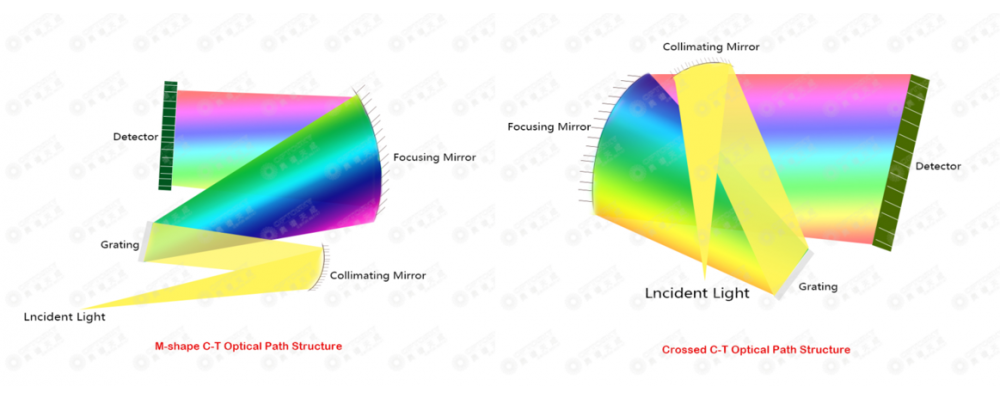Compare Optical Path of Crossed vs M-shape C-T
Abstract: Since the optical fiber
spectrometer has been invented in the last century, its application has
developed wider and wider. The most two common optical bench types include
crossed Czerny-Turner (C-T) and M-shape C-T. This article describes basic
principle, their advantages and disadvantages in details. The crossed C-T type optical
bench structure is compact, and the sensitivity is higher, but M-shape C-T optical
bench resolution is higher, and the stray light performance is better.
It’s usual to use grating to split light for micro spectrometers. Spectrometers’ optical bench is mainly divided into systems of reflectance and transmittance. Transmittance optical system employs smaller size and higher light intensity, but manufacturing materials lack transmittance lens ranging from far-IR to far-UV causing bias spectral curve, and reflectance lens has no color difference and it can obtain straight spectral plane, and reflectance lens selected for imaging can ensure spectral quality received by detector. As a result, it’s main trend to use reflectance optical bench for spectrometers in the market.
There are two universally adopted optical bench among reflectance mode spectrometers, they are unfolded C-T and crossed C-T. Unfolded C-T structure shape like letter “M”, so called M-shape optical path structure origin.
Fig 1 unfolded C-T structure, optical path shape like letter “M”, so called M-shape optical path. M-shape looks like number “3”, It’s easy-to-remember M-shape spectrometers models named by Optoksy, eg: ATP5030、ATP5034、ATP3030、ATP3034
Fig 1 Crossed C-T Optical Path Structure
Optical performance is influenced by main factors including NA, spherical aberration, image aberration, coma aberration and various astigmatism, and determine system optical sensitivity, stray light and optical resolution.
It’s inevitable to avoid spherical aberration, because common spectrometers use ball reflector, which can not eliminate various spherical aberration in the system. Both Crossed C-T and M-shape C-T can calibrate spherical aberration to a certain level, and spherical aberration is an accumulated mode. M-shape optical path structure can narrow relative aperture to make spherical aberration less than tolerance limit of image aberration in order to improve resolution a lot. If it’s needed to further eliminate spherical aberration, it can optimize design by means of paraboloidal or free-form surface, but process difficulty and cost much more, at present still have not been accepted by the market.
It’s a distinctive feature to calibrate coma aberration of M-shape C-T reaching up to an ideal value, and obtain regular spectral spot, and it turns out to be a great improve the resolution.
M-shape C-T has a natural advantage on optimizing astigmatism, because it can calibrate astigmatism to a very low level. On the contrary, crossed C-T has weaker astigmatism calibration, as a result, M-shape C-T employs higher resolution than crossed C-T type.
M-shape C-T is a symmetric optical path structure featuring better stray light result than crossed C-T. However, this index cannot be reflected directly on stray light difference of two types of system. Stray light can be resisted through external optical trap, internal absorbing materials used or increase roughness, so as to improve absorbing diffuse reflection, then eliminate stray light as a result.
Crossed C-T is developed from M-shape C-T optical path. It usually calls crossed C-T as folded optical path. So called folded type has an inevitable advantage on compact structure size and efficient space, so that crossed C-T has gained increasing popularity in developing micro spectrometers. M-shape C-T is a type of unfolded optical path with less compact structure size and less efficient space utility.
Resolution is one of the most important parameters for spectrometers. It can be seen through optimizing design of image aberration, M-shape C-T employs higher resolution. Higher resolution spectrometers apply for M-shape C-T optical bench, and fair resolution spectrometers favor crossed C-T.
Optosky provide a full range of spectrometers including M-shape C-T and Crossed C-T can satisfy customers in various application industry.
ATP2000,
ATP5020, ATP3040, ATP5040 employs crossed C-T featuring compact size and
higher sensitivity;
ATP3030,
ATP5030, ATP3034, ATP5034 employs M-shape C-T featuring higher resolution
and low stray light.


















Comments: 0
No comments